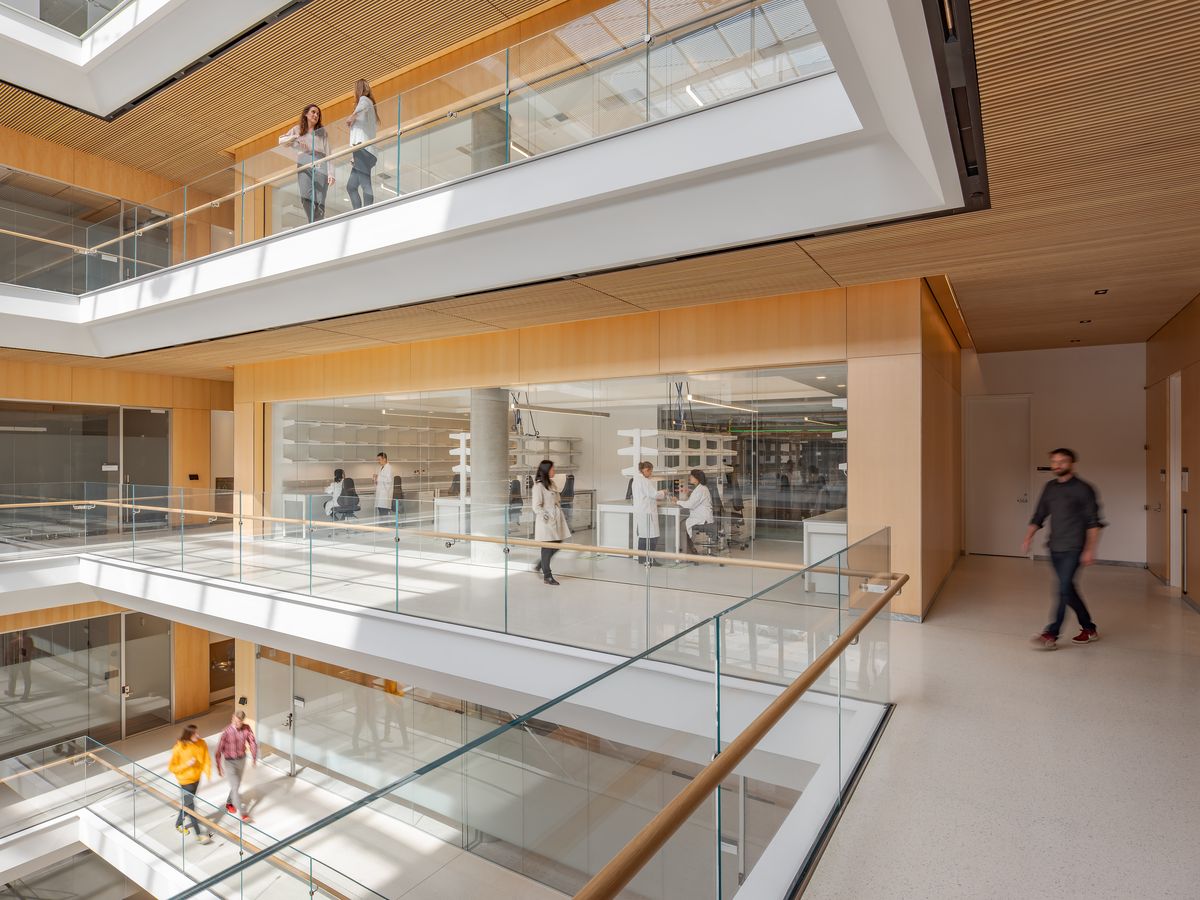The University of California, San Francisco’s neuroscience program works toward solving challenging problems related to the human brain, with the goal of reducing suffering caused by neurologic and psychiatric diseases. UCSF opened the Joan and Sanford I. Weill Neurosciences Building in October 2021 to further its research into clinical treatment, diagnostics, testing, and research of the brain and nervous system. The goal of this collaborative hub is to bring neuroscience research and clinical treatment under the same roof.
For developing a lab facility that brings together patients, doctors, and researchers so that they may interact more effectively as they develop integrated research and translational medicine, Lab Manager has awarded SmithGroup with the Excellence in Innovation prize in the 2023 Design Excellence Awards. SmithGroup served as the architect of record, laboratory planning, and interior design firm for the Joan & Sanford I. Weill Neurosciences Building in San Francisco, CA. Mark Cavagnero Associates was the design architect.
The goal of this collaborative hub is to bring neuroscience research and clinical treatment under the same roof.
“With the mission to support breakthroughs in brain health, the Joan & Sanford I. Weill Neurosciences Building at UCSF creates a ‘Place of Hope’ and operates as a true example of how to successfully fuel connectivity between scientific research, medical clinicians, and neurological education,” says Suzanne Napier, FAIA, vice president, SmithGroup. “Together with our client, design, engineering and building partners, SmithGroup is extremely proud of this dynamic and first-of-its-kind project.”
Cross-discipline collaboration to spur innovation
The UCSF Mission Bay campus was established in 2003 with the completion of its first research building, Genentech Hall. Throughout the 20 years that have followed, other buildings—Sandler Neurosciences Center, Arthur and Toni Rembe Rock Hall, and a future home for psychiatry clinical care and research—have joined or will join the complex to become one of the largest neuroscience hubs in the world.

In order to encourage collaboration on the Weill Neurosciences Building, the project team utilized a “Big Room” cross-discipline teaming approach (housing 100 people and 15 or more companies at a time). The owner, architect, engineering, and builder teams were gathered into the same room to spur timely, integrated problem-solving conversations and make quick design decisions. The multi-firm and discipline group was organized into three sub-teams, with some individuals participating in multiple teams:
- Clusters: site, structure, exterior, MEPF, interior, conveying, equipment and furnishings
- Planning: design, construction, BIM
- Leadership: project solutions (PSG), project management (PMT), senior management (SMT), executive design committee (EDC), owner architect contractor (OAC)
Participants were given Lean Training, with the goal of delivering the projects on time and within budget, while minimizing waste and rework, improving safety, and achieving higher levels of customer satisfaction. A challenge that arose during the construction phase of the building was the start of the COVID-19 pandemic in the United States, which temporarily halted the project for about two months. With over 300 people working on the project, new protocols were developed in order to bring everyone back to the job safely while maintaining health and safety standards.
The concept of team collaboration carries over to the design of the building, which consolidates research typologies previously located in other buildings and on other campuses in order to encourage innovation and discovery in a central location. Individual research hubs consist of an open wet lab, a dry lab, a computation lab, support labs, specialized/flex support labs, in/out space, a linear equipment room, behavioral/testing suites, an environmental room, write-up/office/collaboration space, and a freezer farm. A glass wall and door separates the six ACH (air changes per hour) wet lab from the recirculated air office environment of the dry lab, in order to create a strong visual connection between the two. Workstations and huddle rooms are located close to—but outside—the wet labs, enabling lab techs to safely have lunch and socialize or network in close proximity to their lab benches.
Office sizes for PIs (principal investigators) have decreased over the last 20 years at UCSF for a variety of reasons—for example, PI offices in the 2003-era Genetech Hall were over 200 square feet, with the intention of attracting PIs to this new building. Weill Neurosciences Building’s PI offices are 80 square feet, but the facility also houses neighborhood suites that accommodate 11 PIs, demonstrating how shared collaboration space has become a priority for research. The architecturally screened glass curtain wall in the PI office offers access to natural daylight, in order to allow occupants to maintain the rhythms of the day during their long working hours.
Lab Management Certificate
The Lab Management certificate is more than training—it’s a professional advantage.
Gain critical skills and IACET-approved CEUs that make a measurable difference.
Safety and energy saving features
The Weill Neurosciences Building is projected to achieve an energy usage intensity (EUI) of 85 kBTU/sf/yr through several energy efficiency measures—this EUI level is significantly lower than a typical lab building and is 24 percent lower than the ASHRAE 90.1-2010 baseline. The engineering systems allow for flexibility between sterile to non-sterile areas, and barrier to non-barrier to split within the vivarium proper. This unique feature allows significant flexibility to the University's research team. The baseline EUI of this building was established as a combination of hospital and medical office building (EUI of 400-450), since the Architecture 2030 challenge does not include laboratory buildings in the database. For such a baseline, the project meets the Architecture 2030 challenge.

Strategies to reduce energy consumption include advanced metering and air handling unit controls, wet bench research labs with six ACH, reduction in exhaust air measures, nighttime exhaust air setbacks, a lowered background air change rate, lab airflow and temperature reset, efficient condensing boilers, an efficient central cooling plant, a high-performance building envelope, optimized exterior shading, automated interior shading system, and efficient LED lighting fixtures.
The building exterior screen system provides several benefits including softening of night glow for the lab lighting at night, a sensed movement of the façade as one walks around the building and reduction of heat load to the building resulting in reduced energy usage.
The Weill Neurosciences Building’s location in San Francisco means that, in addition to the usual environmental- and safety-related precautions for a lab facility, earthquakes also need to be considered. The building was therefore designed with a stiff concrete frame, with floors that average 14 inches thick and concrete shear walls that measure 24 inches thick. The building skin underwent performance mock-up testing under conditions to withstand an M7 seismic scenario without system failure. For enhanced safety, the facility was also tested to an M8 seismic scenario and demonstrated that it could meet this higher event threshold without delta fallout of elements. The facade systems will move with the building and will also be able to resist water and air penetration from a seismic event. It will also accommodate over six inches of lateral drift without loss or detachment of cladding materials. These structural enhancements have given the building an anticipated lifespan of 50 years.
Personal comfort as part of the healing process
The design of the Weill Neurosciences Building aims to destigmatize the patient experience and offer world-class care through the use of a light-filled open interior that puts “science on display” while maintaining patient privacy. A light, airy atrium organizes the facility so that patients can see scientists working toward medical advancements, with the aim of encouraging patients to participate in trials. The building is architecturally conceived “as a pair of programmatically driven wings,” says SmithGroup’s Design Excellence Awards entry—these wings are positioned around the public atrium.
Soft uplighting, calm finishes, and enhanced acoustics are designed to offer comfort to neuro patients, while light-filled family lounges create a connection to nature that helps ease anxiety. These lounges are also spacious and clutter-free, with six-foot corridors, to give space for mobility aids and for patients’ assistants. Stairs and elevators are clearly visible, and there is light at the end of corridors, so that wayfinding is less of a challenge for those with neurological impairments. Flexible, U-shaped connected clinical suites are able to expand or contract according to changing clinical demands. Inclusivity is addressed with gender-inclusive restrooms as well gender-specific restrooms, lactation and meditation rooms, and barrier-free building access with sliding door and curb-less drop-off.
Stephen Hauser, MD, director, UCSF Weill Institute for Neurosciences, was quoted in the Design Excellence Awards submission as saying, “This center is going to have an impact that is beyond what we can imagine today and will only amplify in future generations.” Through its thoughtful layout and flexibly designed spaces, the Weill Neurosciences Building hopes to bring together the finest minds in the world to solve some of the most complex and debilitating issues related to the human brain.













